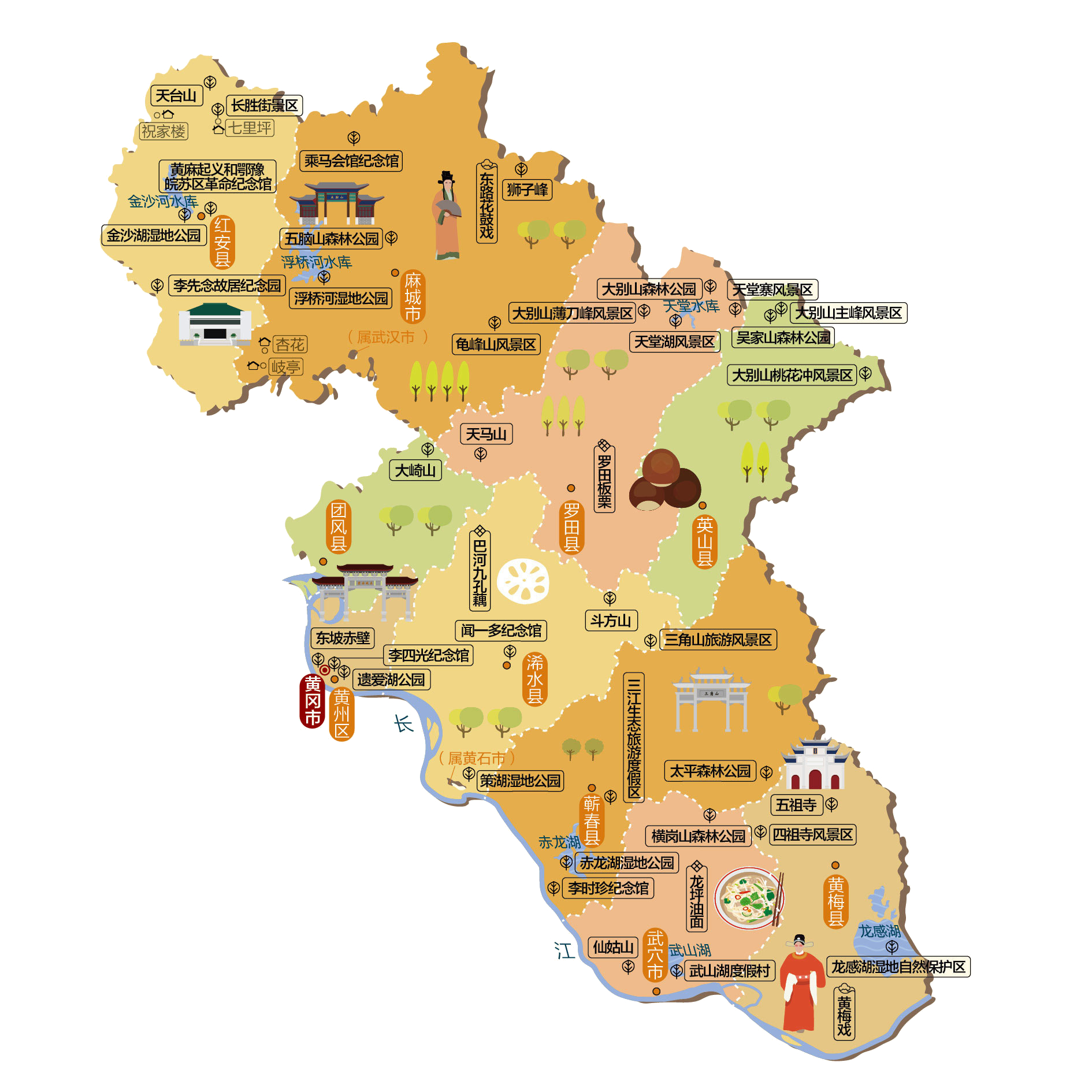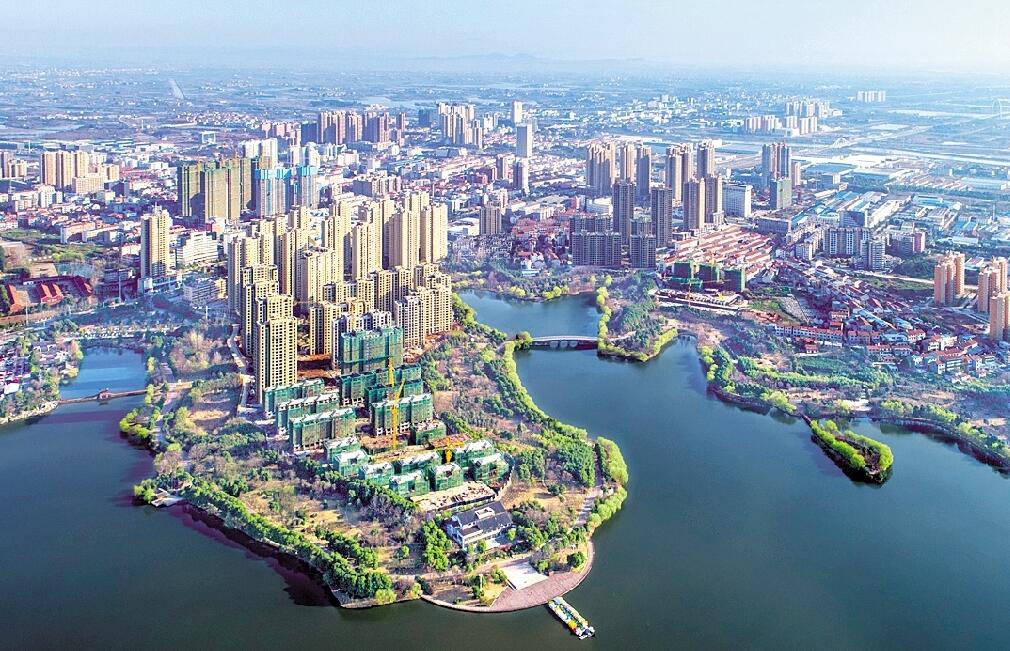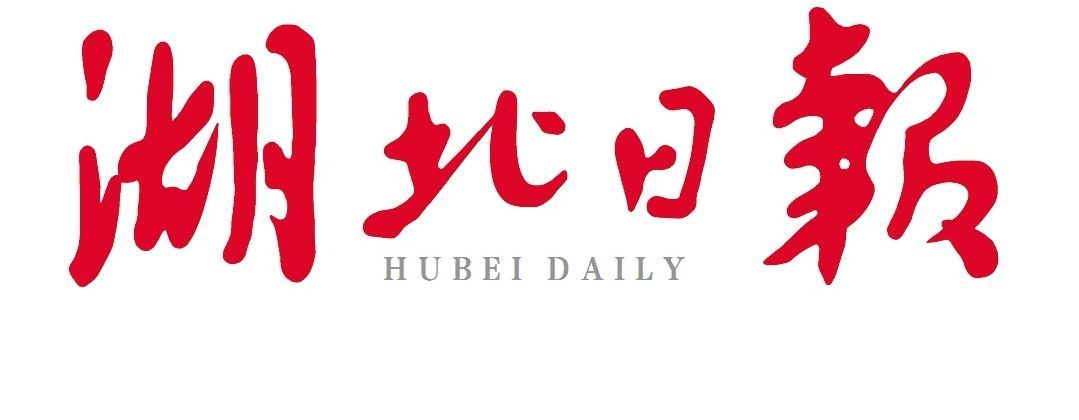
Deutsch-Chinesische Enzyklopädie, 德汉百科
 Hubei Sheng-HB
Hubei Sheng-HB


 Anhui Sheng-AH
Anhui Sheng-AH
 China
China
 Henan Sheng-HA
Henan Sheng-HA
 Hubei Sheng-HB
Hubei Sheng-HB
 Jiangsu Sheng-JS
Jiangsu Sheng-JS
 Beijing-Hangzhou Grand Canal
Beijing-Hangzhou Grand Canal
 Shandong Sheng-SD
Shandong Sheng-SD





黄鹤楼位于中国湖北省武汉市武昌蛇山上,是江南四大名楼之一,中国国家旅游胜地四十佳之一。黄鹤楼共5层,高50.4米。始建于三国时代吴黄武二年(公元223年),距今已有1780多年历史,历代屡修屡毁,现在的黄鹤楼是于1985年重建的。
Errichtet wurde die Anlage im Jahre 223, während der Zeit der drei Reiche (三國 / 三国), als Holzkonstruktion. Im Laufe der Jahre wurde der Turm öfter durch Feuer, aber auch durch wechselnde Herrscher zerstört. Somit durchlief er unterschiedliche Stadien des Aussehens. Im Inneren des Turms findet man heute Holztafeln und Modelle, die die Geschichte und die Veränderungen mit der Zeit erläutern und zeigen.
Cui Hao (chin. 崔顥 / 崔颢 Pinyin Cuī Hào), ein gefeierter Dichter der Tang-Dynastie (唐朝), besuchte das Gebäude im frühen achten Jahrhundert. Sein Gedicht mit dem Namen „Huanghe-Turm“ machte den Turm zum bekanntesten Gebäude in Südchina.
Einem Gedicht des tangzeitlichen Literaten Li Taibo (701-62) verdankt der Turm der gelben Kraniche seinen Ruhm und die Tatsache, dass er nach dutzendfacher Zerstörung stets wieder neu errichtet wurde - zuletzt 1985. Das jetzt 51 m hohe Gebäude mit seinen fünf Stockwerken ist der imposanteste der »Drei großen Türme südlich des Yangzi« (die anderen stehen in Yueyang und Nanchang). Es befindet sich auf dem Schlangenberg (She Shan), gleich östlich der großen Yangzi-Brücke. Frühling und Winter tgl. 7.30-15.15 Uhr, Sommer und Herbst 7-18.30 Uhr, Eintritt 50 Yuan。
黄鶴楼(こうかくろう、簡体字: 黄鹤楼、拼音: )は、現在の中華人民共和国武漢市武昌区にかつて存在した楼閣。現在はほぼ同位置に再建された楼閣がある。武漢随一の名勝地であり、中国の『江南三大名楼』のひとつである。
李白の代表的な漢詩「黄鶴楼にて孟浩然の広陵に之くを送る」や崔顥の「黄鶴楼」にてその名を知られている。
三国時代の223年、呉の孫権によって軍事目的の物見櫓として建築されたが、後には主に観光目的の楼閣になった。唐の永泰元年(765年)に書かれた閻伯瑾「黄鶴楼記」に楼閣の盛大な様子を記している[1]。
黄鶴楼は幾度も焼失と再建が繰り返された。清の光緒10年(1884年)の火事で失われた後、1904年に湖北巡撫の端方の命令により黄鶴楼の旧蹟地に建てられた2階建ての西洋式の火の見櫓と1907年に張之洞の門生らに建てられた「奥略楼」があったが、両方とも1955年に武漢長江大橋の建設のために取り壊された[2]。
黄鶴楼には、以下のような伝承が残っている。
昔、辛氏という人の酒屋があった。そこにみすぼらしい身なりをした仙人がやってきて、酒を飲ませて欲しいという。辛氏は嫌な顔一つせず、ただで酒を飲ませ、それが半年くらい続いた。 ある日、道士は辛氏に向かって「酒代が溜まっているが、金がない」と言い、代わりに店の壁にみかんの皮で黄色い鶴を描き、去っていった。 客が手拍子を打ち歌うと、それに合わせて壁の鶴が舞った。そのことが評判となって店が繁盛し、辛氏は巨万の富を築いた。
その後、再び店に仙人が現れ、笛を吹くと黄色い鶴が壁を抜け出してきた。仙人はその背にまたがり、白雲に乗って飛び去った。
辛氏はこれを記念して楼閣を築き、黄鶴楼と名付けたという。
Yellow Crane Tower (traditional Chinese: 黃鶴樓; simplified Chinese: 黄鹤楼; pinyin: Huánghè Lóu) is a traditional Chinese tower located in Yellow Crane Tower Subdistrict, Wuchang District, Wuhan, in central China. The current structure was built in 1981, but the tower has existed in various forms since not later than AD 223. The current Yellow Crane Tower is 51.4 m (169 ft) high and covers an area of 3,219 m2 (34,650 sq ft). It situated on Snake Hill (蛇山), one kilometer away from the original site, on the banks of the Yangtze River in Wuchang District.
The Yuanhe Maps and Records of Prefectures and Counties, written almost 600 years after the construction of the tower, notes that after Sun Quan, founder of the kingdom of Eastern Wu, built the fort of Xiakou in 223, a tower was constructed at/on the Yellow Crane Jetty, west of Xiakou, and hence its name.[1][2]
The tower has been destroyed twelve times, both by warfare and by fire, in the Ming and Qing dynasties and was repaired on ten separate occasions. The last tower at the original site was built in 1868 and destroyed in 1884. In 1957, the Wuhan Yangtze River Bridge was built with one trestle of the bridge on the Yellow Crane Tower's site. In 1981, the Wuhan City Government commenced reconstruction of the tower at a new location, about 1 km (0.62 mi) from the original site, and it was completed in 1985.[3]
On January 31, 2018, Theresa May, Prime Minister of the United Kingdom, visited Wuhan and took pictures at the Yellow Crane Tower.[4]
La tour de la Grue jaune (Chinois: 黄鹤楼; Pinyin: Huánghè lóu), ou pavillon de la Grue jaune, est un bâtiment de grande importance pour l'histoire de l'art chinois, édifié à Wuhan, province de Hubei, dans la république populaire de Chine. Son plus haut balcon offre une belle vue du fleuve Yangtze à l'Ouest. À l'Est de la colline on peut également, pour quelques yuans, faire sonner la grande cloche du temple.
Elle est située sur Shéshān (蛇山, « Colline du serpent »), la tour a été détruite de nombreuses fois au cours de ces presque 2000 ans d'histoire et reconstruite de formes différents à chaque époque. La construction actuelle date de 1985 tente de conserver le style architectural des anciennes versions mais la structure est faite de matériaux modernes et possède un ascenseur.
Le premier bâtiment a été construit en 223, au cours de la période des Trois Royaumes, en bois. Au fil des années, la tour a été plusieurs fois détruite, souvent par le feu. Par conséquent, maintenant, à l'intérieur de la tour, à peu-près seules les tables sont en bois.
La Pagoda della Gru Gialla (cinese tradizionale: 黃鶴樓; cinese semplificato: 黄鹤楼; pinyin: Huáng Hè Lóu; letteralmente: "Torre della Gru Gialla") è un edificio di grande significato per la storia dell'arte, che sorge a Wǔhàn, nella provincia di Hubei, nella Repubblica popolare cinese. La pagoda si trova sul Monte Sheshan (conosciuto come la Collina del Serpente), al centro del quartiere di Wuchang e quindi vicino al Chang Jiang. Questa montagna si eleva sensibilmente al di sopra della città, per cui dalla Pagoda della Gru si ha una vista meravigliosa. La pagoda è una ricostruzione di un antico monumento di 1700 anni fa che fu elevato per ricordare la visita di un immortale che salì la collina in sella ad una gru gialla. Da qui il nome "Rupe della Gru Gialla".
La costruzione fu eretta nel 223, durante il Periodo dei Tre Regni (三國), come edificio in legno. Nel corso degli anni la torre fu distrutta sia dal fuoco,sia dai vari proprietari. Di conseguenza il suo aspetto attraversò diverse fasi. All'interno della torre si trovano oggi tavole e modelli di legno, che spiegano la storia ed i cambiamenti che ha subito nel corso del tempo.
Cuī Hào (崔颢), un celebre poeta della Dinastia Tang (唐朝), visitò la struttura agli inizi dell'VIII secolo. La sua poesia dal titolo "La Torre di Huanghe" rese la torre l'edificio più famoso della Cina meridionale.
La Torre de la Grulla Amarilla (en chino: 黄鹤楼, pinyin: Huáng Hè Lóu) es una torre histórica, construida originalmente en el 223 d. C. La estructura actual, sin embargo, fue reconstruida en 1981 a un kilómetro de distancia de su emplazamiento original, y tiene poco parecido con la Torre de la Grulla Amarilla original. Se sitúa en Sheshan (Colina de la Serpiente), en la orilla del río Yangtsé en Wuchang, Wuhan, en la provincia de Hubei, China.
El emplazamiento original de la torre era el Embarcadero de la Grulla Amarilla, al oeste de Xiakou. Los Mapas y Registros de Prefecturas y Condados de la época Yuanhe señala que cuando Sun Quan construyó el fuerte de Xiakou, había una torre que llevaba el nombre del Embarcadero.
Las guerras y los incendios destruyeron la torre muchas veces. Solo durante las dinastías Ming y Qing, la torre fue destruida siete veces, y fue reconstruida y reparada diez veces. La última vez que se construyó durante la dinastía Qing fue en 1868, y fue destruida en 1884. Su emplazamiento fue ocupado posteriormente por los bastidores del Puente de Wuhan sobre el río Yangtsé en 1957. En 1981, el gobierno de la ciudad de Wuhan decidió reconstruir la torre en una nueva localización, a un kilómetro de su emplazamiento original. La torre actual se completó en 1985.









 Geography
Geography

 Architecture
Architecture
 History
History
 Eat and Drink
Eat and Drink
 Medical, Pharmaceutical, Rehabilitation
Medical, Pharmaceutical, Rehabilitation
 Traditional medicine
Traditional medicine